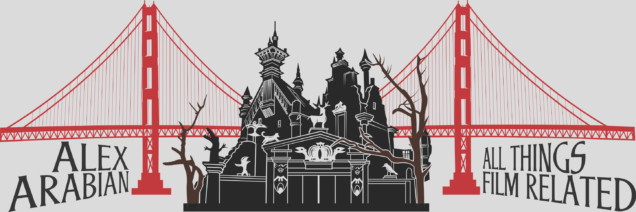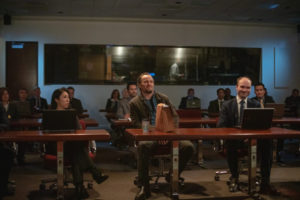[Published at Slash Film] Lauren Greenfield has been a professional photographer since the Reagan era, documenting the American Dream’s devolution into insatiable avarice and a form of capitalism increasingly based on cruelty through a singular lens. She’s also an acclaimed documentarian of the 21st century whose latest film, The Kingmaker, about former First Lady of the Philippines Imelda Marcos, tells a very different kind of wealth story than her previous films. Greenfield is a renaissance woman in every sense of the term. Working on her first narrative feature, Man Under, penned by Better Call Saul’s Ann Cherkis, Greenfield is at the peak of her burgeoning artistic career.
When speaking with Greenfield, it becomes immediately clear that she has a deep love for film. It was always destined to be her endgame. Further, it’s abundantly apparent that Greenfield’s work has consistently been driven by her cinematic inspirations throughout her career.
“I admired the vérité filmmakers like Fred Wiseman, D.A. Pennebaker, also Chris Marker with Sans Soleil.” Greenfield says of her filmmaking influences. “And I studied for a year going around the world, 1985, 1986, studying film and anthropology on a program that Robert Gardner, who’s an anthropological filmmaker, organized.“
Although Greenfield didn’t get into film school, she would pursue film after her second book, “Girl Culture,” when her friend, R.J. Cutler (The War Room) agreed to executive produce her directorial debut, Thin (based on her eponymous first book). Her documentaries further offer an uncompromising lens into the increasingly destructive addiction to wealth that said skewed American Dream begets; there’s an immediacy to her visual presentation that remains effective across the written, still photography, and moving picture mediums in which Greenfield engages. With such a fascinating background in photography and filmmaking that often marries its themes of declining capitalism with that of obsessive popular culture and material indulgence, I felt compelled to pick Greenfield’s brain about her own popular culture tastes beyond her non-fiction work.
For those unfamiliar with Lauren Greenfield’s written and documentarian work, she has you covered. Indulging me in a fun exercise, Greenfield paired her body of work with narrative feature films and television shows for hypothetical double features. Greenfield would prefer her most noteworthy works be screened with subject matter that accentuates her themes of excessive capitalism and its consequences that rear themselves in non-financial ways. Unsurprisingly, she has excellent taste in film:
“Girl Culture” & Mean Girls
A book in which Greenfield explores the relationship with girls, their bodies, personal expression, and popular culture in modern America and a film in which Tina Fey satirizes the hyper-competitive nature of female high school cliques, starring Lindsay Lohan, Rachel McAdams, Amanda Seyfried, Lizzy Caplan, and Lacey Chabert.
In Mean Girls, physical beauty, emulating the sex-infused popular culture of the early 2000s, and maintaining an acceptable public appearance are of the utmost importance in joining Rachel McAdams’s “popular” clique. “Girl Culture” dissects the very notion of the popular clique; the cheerleader, aspiring models, actresses, the complex, interpersonal relationships among and between women in the public eye and behind closed doors in an increasingly competitive society. While Mean Girls aims to satirize popular clique culture among young women, “Girl Culture” aims to understand it from a more sobering approach. Further, both films empathize with the way young girls and women are forced to navigate through this oppressive world.
“Fast Forward” & Beverley Hills 90210, Less Than Zero, & Thirteen
A book in which children of all social and cultural backgrounds in LA discuss their obsession with celebrity and its materialistic allures and a show in which the romantic lives of six privileged white teens are dissected against the backdrop of an affluent Los Angeles neighborhood during the tail-end of the “greed is good,” Gordon Gecko era in the 1990s.
Similarly to what “Fast Forward” does with the children featured in the documentary, Darren Star’s Beverly Hills 90210 examines the first-world problems that accompany a life of excess in a thoughtful, albeit cheesy manner. Shannen Doherty’s Brenda Walsh strives to fit in with the popular crowd at all costs, engaging in illicit behavior to do so, Jennie Garth’s Kelly Taylor is the spoiled, popular “mean girl,” if you will, obsessed with material possessions, Ian Ziering’s Steve Sanders is the rich kid with the corvette and the endless allowance from dad, and Jason Priestley’s Brandon Walsh is the moral glue holding these characters together. As in “Fast Forward,” set in the milieu of celebrity culture (Brandon’s boss and mentor is even a retired character actor), 90210 isn’t afraid to show the negative implications of the young populations of our society exposed to materialism at such a young age: depression, anxiety, alcoholism, drug addiction, eating disorders – many topics Greenfield consistently explores throughout her work.
That takes us to Less Than Zero, which renowned film critic Roger Ebert claimed “knows cocaine inside out and paints a portrait of drug addiction that is all the more harrowing because it takes place in the Beverly Hills fast lane…[Robert Downey, Jr’s] acting here is so real, so subtle and so observant that it’s scary…The whole movie looks brilliantly superficial, and so Downey’s predicament is all the more poignant: He is surrounded by all of this, he is in it and of it, and yet he cannot have it.” Adapted from a Bret Easton Ellis novel, it takes place during the height of the “greed is good,” Gordon Gecko era in the 1980s.
Less Than Zero is a dystopian snapshot of superfluously silk-stocking young Generation Xers, portraying powerful examples of what excessive wealth and the incessant drive for it can do to human beings, particularly our youth. Drug addiction, prostitution, senseless violence. Much like in “Fast Forward,” images of opulence featuring extravagant cars are juxtaposed with contrasting scenes of poverty, gang dynamics, and destitution.
And then there’s Thirteen, in which a rebellious thirteen-year-old (Evan Rachel Wood) follows a dangerous rabbit-hole down self-destructive drug-addiction and sexual promiscuity. Emulating the cinéma vérité style of Greenfield’s documentary work, Catherine Hardwicke’s Thirteen follows two particularly lost youths. Wood’s Tracy yearns for human connection. Nikki Reed’s Evie is a manipulate young girl with an insatiable greed for instant material gratification and the rush that comes with it. Engaging in stealing to keep up with their growing kleptomaniac habits, they evolve to drug use, promiscuity, and self-harm to maintain the rush that greed and power gives them. Whereas Beverley Hills 90210 and Less Than Zero focus on particular stages during the “Greed is good” era and its effects on youth, similarly to “Fast Forward,” Thirteen shows the effects of that collective mindset on the following generation’s children. Ultimately, each subject in Greenfield’s choice of double features, here, depicts youths desperately chasing a celebrity lifestyle, or rather, what they’ve come to understand what that represents to them.
Thin & Girl, Interrupted
A documentary in which the epidemic of eating disorders is analyzed. It emphasizes that pyschopathologies are reflective of historical time periods, and that eating disorders are more common in affluent countries and…
“What was the one about Winona Ryder, and she was in a mental hospital?” Greenfield asks me as the title suspiciously escapes her, displaying her characteristic humility, seemingly feigning naïveté. That would be Girl, Interrupted, in which the complex dynamics of mentally ill women left to fend for themselves in deteriorating institutions are explored in James Mangold’s thoughtful directorial effort.
Throughout Girl, Interrupted, several mental illnesses, including anorexia and bulimia, are profiled. Not coincidentally, two of the four women featured in Thin have anorexia nervosa and bulimia nervosa. Thematically, this film pairs harmoniously with Thin, particularly due to the enduring tales of hospitalization relating to the four main subjects that emulate the dramatizations depicted in Girl, Interrupted. Perhaps most impactful about this pairing of films is the comment they make on the lack of care that the government puts into our public institutions, particularly mental hospitals. The poor conditions shown in both features serve as a testament to the lack of proper funding and care provided to the people most in need within the confines of a profit-driven society.
Kids + Money & The Bling Ring
A short documentary in which children of all economic backgrounds reflect upon their troubling fixation on money and…
“What was that Sofia Coppola one where the girls all stole stuff?” Greenfield asks me again, this time the title genuinely slipping her sharp, all-encompassing mind. A rare moment. That would be The Bling Ring, a film in which Katie Chang, Israel Broussard, Emma Watson, Taissa Farmiga, and Claire Julien satisfy impulsive cravings to feed their addictions to wealth and celebrity by embarking upon a series of increasingly reckless burglaries.
Based on a true story, The Bling Ring follows young women who raid celebrity homes. Much like the subjects featured in Kids + Money (may they be happy and healthy today), the economically diverse characters in Coppola’s film have an obsession, not only with money, but with what money has come to represent to them: celebrity, love, admiration, acceptance in a place in this increasingly isolated society. If there is one thing the children of Kids + Money and the teenagers of The Bling Ring have in common, it’s that they’ve been conditioned to view money as the only through-line to being loved and accepted. And isn’t that what we all want?
The Queen of Versailles & The Big Short
A documentary in which a couple builds a $100 million home during the Great Recession, striving to build the most expensive single-family home in one of the worst economic crashes in U.S. history: “I almost feel like Queen of Versailles could be its own fiction movie.” Explains a contemplative Greenfield. “Jackie’s unique…there’s certainly a lot of overlap, content-wise, with The Big Short.” She pairs it with that very film, in which the Great Recession, or the financial crisis of 2008, is explained in hilariously layman’s terms for us common folk throughout this satirical meta-work by Adam McKay.
The Big Short explains exactly how the housing crisis of 2008 began. An extremely unregulated housing market, the reckless conversion of subprime loans into collateralized debt obligations, empty handouts to people with poor credit, creating even more money that was never there to begin with, and a whole heap of confused people of both sides of the crash. In The Queen of Versailles, Jackie and her husband are unwitting victims of the financial crisis that The Big Short deconstructs. The market led them to believe that the debt limit, and by proxy, their financial constrictions, were nonexistent. They had so many subprime loans, they didn’t know what to do with them.
Generation Wealth & The Wolf of Wall Street
A documentary in which Greenfield reveals “The destructive and understandable driver of late-stage capitalism and how it’s unsustainable, not just for our economy, but also for our environment and our relationships and our souls […] Those values in Generation Wealth of celebrity and narcissism and materialism and image have grown out of the American Dream, but have really corrupted the American Dream. There’s been a sea of change in the last generation where the American Dream used to be about wealth or material success being an expression of contribution and not fame for fame’s sake, money for money’s sake, doesn’t matter how you get it.”
She pairs it with The Wolf of Wall Street, in which Martin Scorsese portrays the life and times of real-life stock broker-turned white collar criminal-turned motivational speaker Jordan Belfort. Drugs, sex, and reckless abandon with unburdened Benjamins, The Wolf of Wall Street provides a glimpse into the world out of which so many former investment bankers, hedge fund managers, and financial executives find themselves barely making it alive.
The Wolf of Wall Street precisely shows the “narcissism and materialism and image” that has tragicomically corrupted the American Dream which Greenfield refers to in Generation Wealth. It is, quite literally, a cautionary tale about the pursuance of “money for money’s sake,” no matter “how you get it.” The addiction to greed and the expression of money for money’s sake almost destroyed Belfort. Both cautionary tales, these two films are worthy companion pieces about the fundamental, humanistic demonization of the blind pursuance of wealth.
The Kingmaker & Evita
Although, don’t tell Imelda. “She doesn’t like being compared to Evita.” Greenfield warns me with a facetious caution. But she still pairs it with Evita, the movie musical in which the life of former First Lady of Argentina Eva Perón (Madonna), a populist, is analyzed.
These films exist as opposites, in many aspects. Marcos was a fascist, authoritarian leader. Perón was a populist with leftist policies way ahead of her time, believing in the power of the people over a select elite. It’s no wonder why Marcos detests the comparison. They were mutual antitheses, as leaders, but both came from poverty and longed to be loved by their people. Whereas Marcos’s dynasty engaged in martial law against political and religious dissenters, cracked down on freedom of press, and was troublingly nationalistic, skewing its distribution of wealth away from the common people, Perón and her husband, Juan Perón, created unions, collective bargaining rights for workers, a minimum wage, steps towards universal housing, health, and education, and other social programs that benefited the proletariat. If The Kingmaker exists as as cautionary tale, Evita exists as an example of a more effective way of governing.
If only the powers that be in this industry could make these double features happen (with the books presented as audio-recordings, of course), it would be one of the most powerful, prescient meta-art exhibits perfectly encapsulating our troubled times. And that is precisely what Greenfield does best. She provides an unbridled perspective into a society in decline, desperately attempting to maintain an image that never accurately depicted its essence.
Continuing her eye for observing crazed consumerism, this time analyzing how it destroys the fabric of democracy, Greenfield presents The Kingmaker’s narrative in her most urgent tone yet. At once drawing parallels from the authoritarian regimes of Fernando Marcos and Rodrigo Duterte to that of Donald Trump’s presidency, The Kingmaker shows what money can “achieve” beyond fame: political influence. Global capitalism willfully supported the Marcos dynasty, even as each of its political institutions and democratic safeguards disintegrated, as long as they “played the game,” so to speak. The Marcoses opened up the Philippines to IMF structural adjustment and neoliberalism, paralleling not only what is happening in the U.S., but all over the world. Despite embezzling millions from their citizens, the Marcos family remains a prominent voice in modern conservative Philippines. The relocation of the entire Calauit people from their island is another prime example of such a gross abuse of capitalism. It captures but a few of the lasting scars left by the Marcoses on their people.
“The island was a symbol of the recklessness of wealth and power and how, on a whim, an impulse, somebody makes a decision that affects, in this case, people and animals for generations. That one decision uproots hundreds of people and puts the animals in a kind of doomed purgatory, where they have four generations of inbreeding and no veterinary care and not enough food and no way out. No future. And as the movie progresses, the island, and specifically the inbreeding, also becomes a metaphor for political dynasty and the ill effects of political dynasties flourishing.”
For readers who have viewed or read any of Greenfield’s work and experienced a sensation of empowerment, hope, energy, and/or inspiration to make changes either in their own lives or by contributing to a greater cause, that effect isn’t entirely unintentional on Greenfield’s behalf. It isn’t a subliminal message, but rather an overt, assertive one canvassed into the viewer’s psyche by the artist.
“It’s not a happy ending.” Greenfield says of The Kingmaker. “In a way, Generation Wealth was unusual for me because it has a little bit of a hopeful ending. I’m often looking at deconstructing the problems in a way that makes you think and hopefully is a call to action, whatever that means for you.“
In Generation Wealth, former hedge fund manager and recovering “wealth addict” Florian Homm refers to Harvard Business School as “The West Point of Capitalism.” Greenfield asks if the program teaches young men and women to be good people, to which Homm laughs hysterically, replying, “We’re fine-tuned to rule the world.” Not coexist. Has a profit-driven approach to an economy made competition impossible for people live in harmony with one another? Greenfield appears certain that capitalism is the root of this epidemic of addiction to wealth.
“It’s soul killing in the way that Florian discovers in terms of chasing something at the cost of everything else and losing yourself in the process…what I discovered was it was more about addiction than about greed, and sometimes the only way to wake up from addiction is to hit rock bottom.”
“It’s like the end of Rome,” Says former New York Times journalist Christ Hedges over a forewarning montage in Generation Wealth. “The pyramids were built at the moment of precipitous Egyptian decline, and that’s what always happens: Societies accrue their greatest wealth at the moment that they face death.” Is Greenfield’s career work indicative of our societal downfall, then? If Generation Wealth shows how a cultural movement (the aforementioned addiction to wealth) destroyed a nation’s values, then The Kingmaker depicts how a political dynasty destroyed the left momentum in the Philippines, paving the way for Duterte. Similarly, Ronald Reagan and Margaret Thatcher did the same in the west by crushing the power of organized labor, abolishing public programs, and shifting the Overton window in a slightly more rightward, less freedom-oriented direction, paving the way for Trump and Boris Johnson. Therefore, any new left movement is essentially disembodied from its past in a modern historical context. However, perhaps the recent wave of democratic socialism offers a potential answer.
“There are a lot of signs that people are realizing that this is not the way, particularly among the millennials. Those are rays of hope. But addiction is so powerful that there has to be a critical mass that really wants to go in that direction, and then the institutional change behind it. That’s why I used Iceland as a case-study for the possibility of change because their crash was so terrible, and they were not able to be bailed out. And they used it as a prompt to reconsider their values and the direction they’ve been going in and deciding consciously as a society they were going to change government, bring in women, bring in different kinds of leaders. They felt testosterone was part of the problem…And it actually worked. It actually created both a stronger society based on their core values, and also, they ended up making money again by going back to the original source of their wealth, which was their fish. But Iceland is a small, homogeneous, wealthy country, and they were able to do that.”
Unfortunately, the United States has a long way to go to restore its elusive American Dream. ROI is about far more than financial return. However, when ROI is misclassified, the concept of diminishing returns takes hold, causing a viscous cycle. It takes a unification of ideologies to shed the indulgence on the only thing more valuable than human life: Dead presidents.
“For us and other places like the UK, they bailed themselves out in a way that just created a climate for the same thing. Right now, we’re just heading for another crash. Our debt is getting bigger and bigger. Aspiration is stronger. The lack of social mobility enhances a kind of aspiration for a false wealth or bling and image. The system is rigged, and the system is becoming more and more rigged. But it’s not easy to get out of that because we’re in a system where money does support political power. Information supports political power.”
“Perception is real, and the truth is not.” States Marcos in The Kingmaker. “That is the commonality with Generation Wealth.” Greenfield reluctantly chuckles. “Fake it ’till you make it.”
Respect, intimidation, and fear have a complex, interrelated relationship with one another, and money is another through-line to achieve that raw power. This addiction to wealth, the image of wealth, and its increasingly dystopian implications in a society that values materialism at all costs over the self-effacing diligence that material possession used to represent in the U.S. has taken hold among our current world leaders.
“It’s really about creating a climate of fear more than anything else.” Says Greenfield in a passionate, admonishing manner. Regarding a real-life call to action as effective as the Iceland case-study, Greenfield explains, “I don’t think we’re at that critical mass for a tipping point.”
***
A Showtime Documentary Films production, The Kingmaker was released theatrically on December 13, and is currently playing in select cinemas across the U.S. It is expected to air on Showtime in early 2020.




![Documentary Filmmaker Lauren Greenfield Shares the Books and Movies You Should Read and Watch Alongside Her Work [Interview]](https://www.makingacinephile.com/wp-content/uploads/2020/01/Lauren-Greenfield-Interview-900x350.jpg)



Leave a Reply
Your email is safe with us.